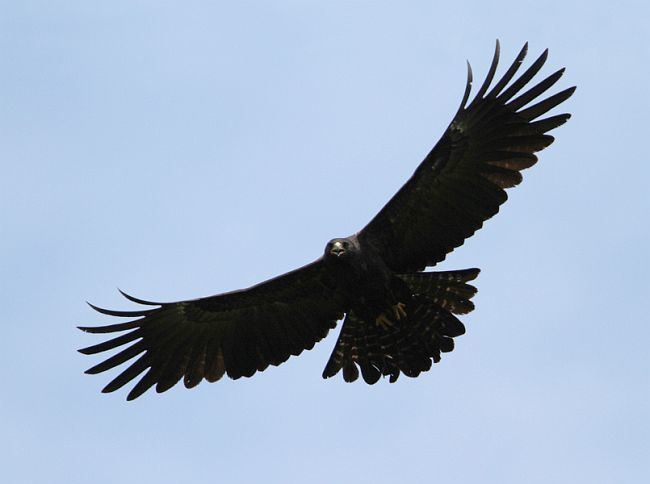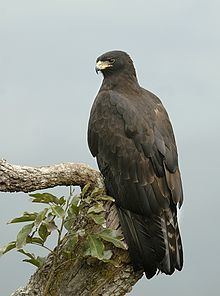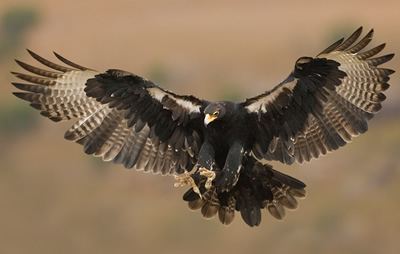Genus IctinaetusBlyth, 1843 Higher classification Ictinaetus | Phylum Chordata Scientific name Ictinaetus malaiensis Rank Species | |
 | ||
Similar Bird, Ictinaetus, Changeable hawk‑eagle, Accipitridae, Verreaux's eagle | ||
The black eagle (Ictinaetus malaiensis) is a bird of prey. Like all eagles, it is in the family Accipitridae, and is the only member of the genus Ictinaetus. They soar over forests in the hilly regions of tropical Asia and hunt mammals and birds, particularly at their nests. They are easily identified by their widely splayed and long primary "fingers", the characteristic silhouette, slow flight and yellow ceres and legs that contrast with their dark feathers.
Contents

Incredible footage of black eagle aggression
Distribution

The black eagle breeds in tropical Asia. Race perniger (Hodgson, 1836) is found in the Himalayan foothills west through Nepal into northeastern Murree in the forests of the Eastern and Western Ghats in peninsular India and Sri Lanka. The species also extends into the Aravalli range of northwestern India. The nominate race malaiensis (Temminck, 1822) is found in Burma, southern China (Yunnan, Fujian) and Taiwan, into the Malay Peninsula. They are generally residents and no migrations have been observed.

In a study in southern India, it was found to favour forests with good forest cover and was absent from areas where the cover was less than 50%.
Description

The black eagle is a large raptor at about 70–80 cm in length and 164–178 cm in wingspan, with a weight of between 1000 and 1600 grams. Adults have all-black plumage, with a yellow bill base (cere) and feet. The wings are long and pinched in at the innermost primaries giving a distinctive shape. The tail shows faint barring and upper tail covers paler. When perched the wing tips reach till or exceed the tail tip. The wings are held in a shallow V (wings just above the horizontal plane) in flight. Seen on hot afternoons, scouring the treetops for a nest to maraud, this bird is easily spotted by its jet black colour, large size, and a 'characteristic' slow flight, sometimes just above the canopy.
Sexes are similar, but young birds have a buff head, underparts and underwing coverts. The wing shape helps to distinguish this species from the dark form of crested hawk-eagle, (Spizaetus cirrhatus). The tarsi are fully feathered and the toes are relatively stout and short with long claws (particularly on the inner toe) that are less strongly curved than in other birds of prey.
The species name is spelt malayensis' in most publications but the original spelling used by Temminck in his description uses the spelling malaiensis according to a 2011 finding of some of the original covers of the part publications leading to taxonomists applying the principle of priority and rejecting any later spelling emendations.
Habits
The black eagle eats mammals, birds and eggs. It is a prolific nest-predator and is known for its slow flight just over the canopy. Due to this eagle's ability to remain aloft for long periods with minimal effort, the Lepcha people of India's Darjeeling district described it as a bird that never sat down. The curved claws and wide gape allow it to pick up eggs of birds from nests. Along with swallow-tailed kites they share the unique habit of carrying away an entire nest with nestlings to a feeding perch. Squirrels, macaques and many species of birds emit alarm calls when these birds are spotted soaring over the forest. The Indian giant squirrel has been noted as a prey of this species and young bonnet macaques may also fall prey to them.
The courtship display involves steep dives with folded wings with swoops up in a U shape into a vertical stall. They build a platform nest, 3 to 4 feet wide, on a tall tree overlooking a steep valley. One or two white eggs which are blotched in brown and mauve may be laid during the nesting season between January and April. The nest site may be reused year after year.
